Meet Hope for Life Rescue
Original article by S. Veigel 03/22/2014
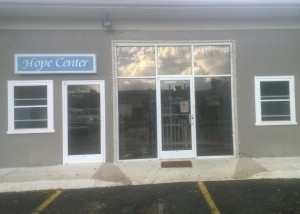
Virginia Beach, Va. 23451
Twenty-eight years ago Pauline was a very self-involved successful business woman living in a condo. At a critical point in her life she noticed some feral cats eating out of the trash; something she never noticed before. Out of concern for the animals she contacted two animal organizations hoping they could help.
Eventually some people from PETA came out and collected the cats. But when she tried to follow up on what happened to them she was disturbed to learn that the cats had been euthanized. She was stunned by the realization that her desire to help the creatures directly led to their demise and she kept it in her prayers for 7 years until she finally decided that she had to do something.
In 2002 Pauline started “Hope for Life Rescue”, a 501 (c) 3 no-kill shelter. She started by rescuing 12 to 15 animals a year funded out of her personal income. Then, as word got out she started receiving animals from Virginia Beach Animal Control and Animal Control in Georgia, North Carolina, South Carolina and Tennessee. By 2012 Pauline took in and placed about 3,500 animals into homes instead of cages. I sat down with Pauline for an interview in December of 2013.
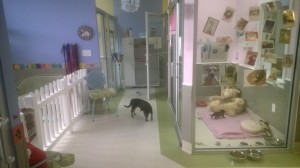 Hope for life is a cage free facility with 2 large dog runs. As you enter Hope for Life Rescue there is a little sitting area with a small attractive white fence. Everywhere you turn there are rooms with clear glass doors where the animals can retire and other hang-out and play areas. In the center is a roomy glass enclosure where mother cats can nurse their young and the kittens can play without the other animals disturbing them. In each “hotel” room there are beds and toys for the animals.
Hope for life is a cage free facility with 2 large dog runs. As you enter Hope for Life Rescue there is a little sitting area with a small attractive white fence. Everywhere you turn there are rooms with clear glass doors where the animals can retire and other hang-out and play areas. In the center is a roomy glass enclosure where mother cats can nurse their young and the kittens can play without the other animals disturbing them. In each “hotel” room there are beds and toys for the animals.
At night when they’re not being supervised the animals at Hope for Life Rescue are more confined in their rooms with the animals they get along with. In the morning the animals are fed and the facility cleaned. Then all the doors are left open permitting the animals to move around freely and interact with each other. Around noon the volunteers arrive and at 12:30 pm the facility is open to visitors
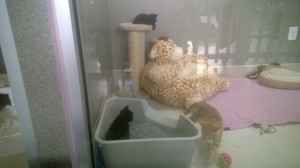 The interesting thing about visiting Hope for Life is watching the dogs walk around with the cats. The cats are playing, lying around on Pauline’s desk and anywhere else they please. One cat was doing a high wire act walking along the partition above my head. He kept following me and rubbing his cheeks on the partition in an effort to get attention. So I just had to reach up and pet him. If I didn’t have my maximum allowable quota of animals already I think I would have taken him home with me.
The interesting thing about visiting Hope for Life is watching the dogs walk around with the cats. The cats are playing, lying around on Pauline’s desk and anywhere else they please. One cat was doing a high wire act walking along the partition above my head. He kept following me and rubbing his cheeks on the partition in an effort to get attention. So I just had to reach up and pet him. If I didn’t have my maximum allowable quota of animals already I think I would have taken him home with me.
The volunteers help where needed. But one of their priorities is to interact with the animals and keep them out of trouble. In one room, as a volunteer showed me around, another volunteer was in a large open storage area getting some cats to play with a toy. In one of the hotel rooms there was a new dog wrapped in a Thunder Shirt for comfort as she lay on a nice Kuranda bed.
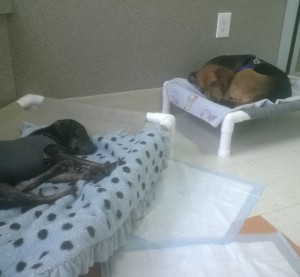
Thunder Shirt and Kuranda beds
At one point I listened as Pauline was speaking to an elderly couple who came in looking for a dog. She explained two of the dogs were mother and child. The mother was in treatment for heart worms and not ready for adoption. The couple didn’t see what they wanted and left to shop around. Which reminded me of how difficult and sometimes heart breaking it is to see these animals, try to help them and try to find them a home.
If I may paraphrase a story from their website to emphasize the level of difficulty, they talk about a kitten whose leg had been snapped in half. It would require $800 in surgery when they only had $200 in their account. But that didn’t deter them. They moved forward with the surgery with nothing more than the faith that they could raise the money and, thanks to their donors, they made it. But how difficult is that to see these animals day after day and struggle to find the money to spare their torment? That’s a level of concern most of us don’t have to deal with. And we should be grateful that these people were there.
Generally when people go to buy or adopt a pet they want an animal that is healthy and cute. So between the Animal Control and Animal Rescue spheres of existence the term “unadoptable” has a different meaning. In an overcrowded animal shelter run by Animal Control that aspect of human behavior means that an animal who’s blind in one eye or disfigured is often considered to be “unadoptable”. That animal will be among the first to be euthanized for the crime of being born and abused or injured. In Pauline’s world an animal would have to be down right mean to be “unadoptable”.
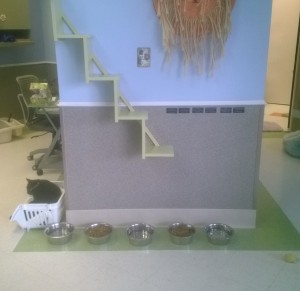 All totaled (in 2013) Pauline will spend about $60,000 (plus) just on veterinarian bills. With food, beds and other special or general products she will then total about $74,000 (plus) just for the animals. On top of this she is trying to fund a couple of employees and facility expenses. Give or take she has to come up with $100,000 (plus) a year just to stay in business. To help with this Hope for Life has the “Hopes Garden Resort Boutique” next door. But that’s not enough by itself. She still desperately depends on donors to survive at the current level and actively works to expand Hope for Life Rescue’s ability to save more animals.
All totaled (in 2013) Pauline will spend about $60,000 (plus) just on veterinarian bills. With food, beds and other special or general products she will then total about $74,000 (plus) just for the animals. On top of this she is trying to fund a couple of employees and facility expenses. Give or take she has to come up with $100,000 (plus) a year just to stay in business. To help with this Hope for Life has the “Hopes Garden Resort Boutique” next door. But that’s not enough by itself. She still desperately depends on donors to survive at the current level and actively works to expand Hope for Life Rescue’s ability to save more animals.
During my visit Pauline explained that she was winding up a record year. She will have taken in 450 animals and expects to have adopted out all, except a couple that are feral.
As I was listening to Pauline describe her transition from business person to running a no kill shelter I joked, “Not exactly a high profit business decision”. And at one point she looked at me in earnest and remarked, “It shouldn’t be about the organization. It’s about the animals”. Then she repeated, “It’s about the animals”.
(See our listings under Virginia Beach, Virginia for “Hope for Life Rescue”)